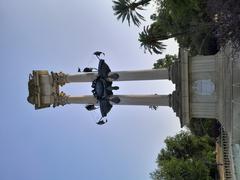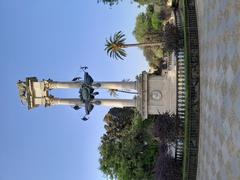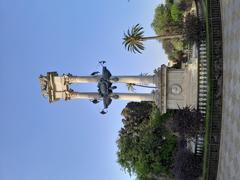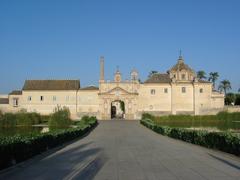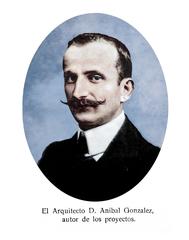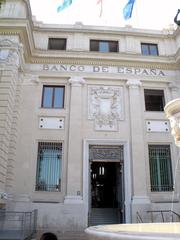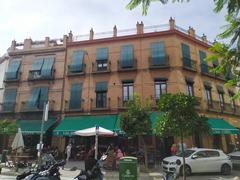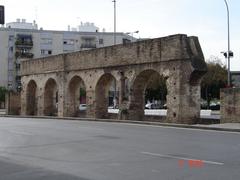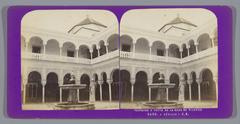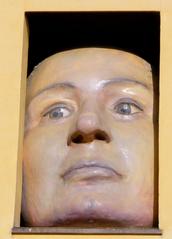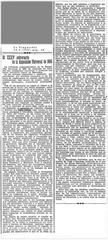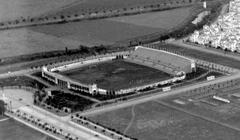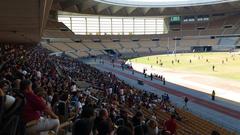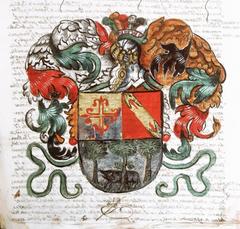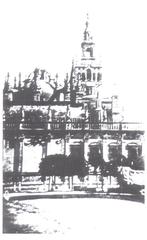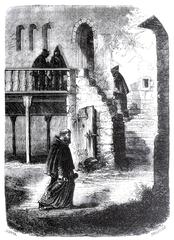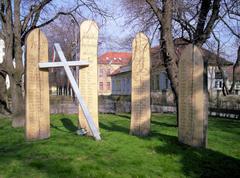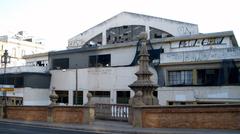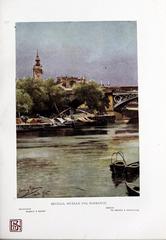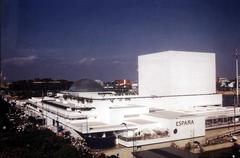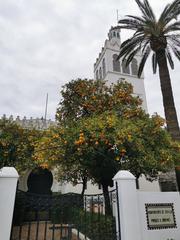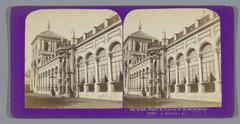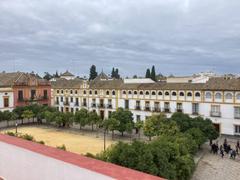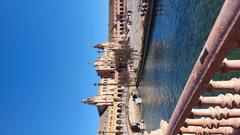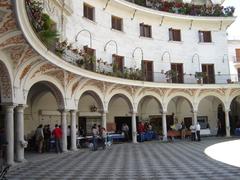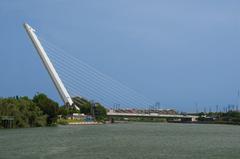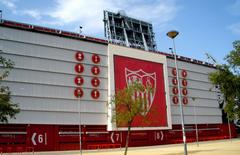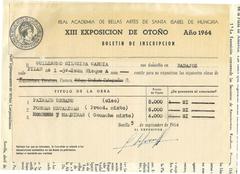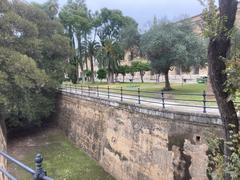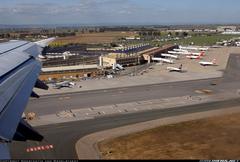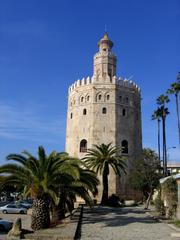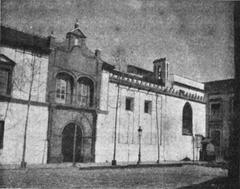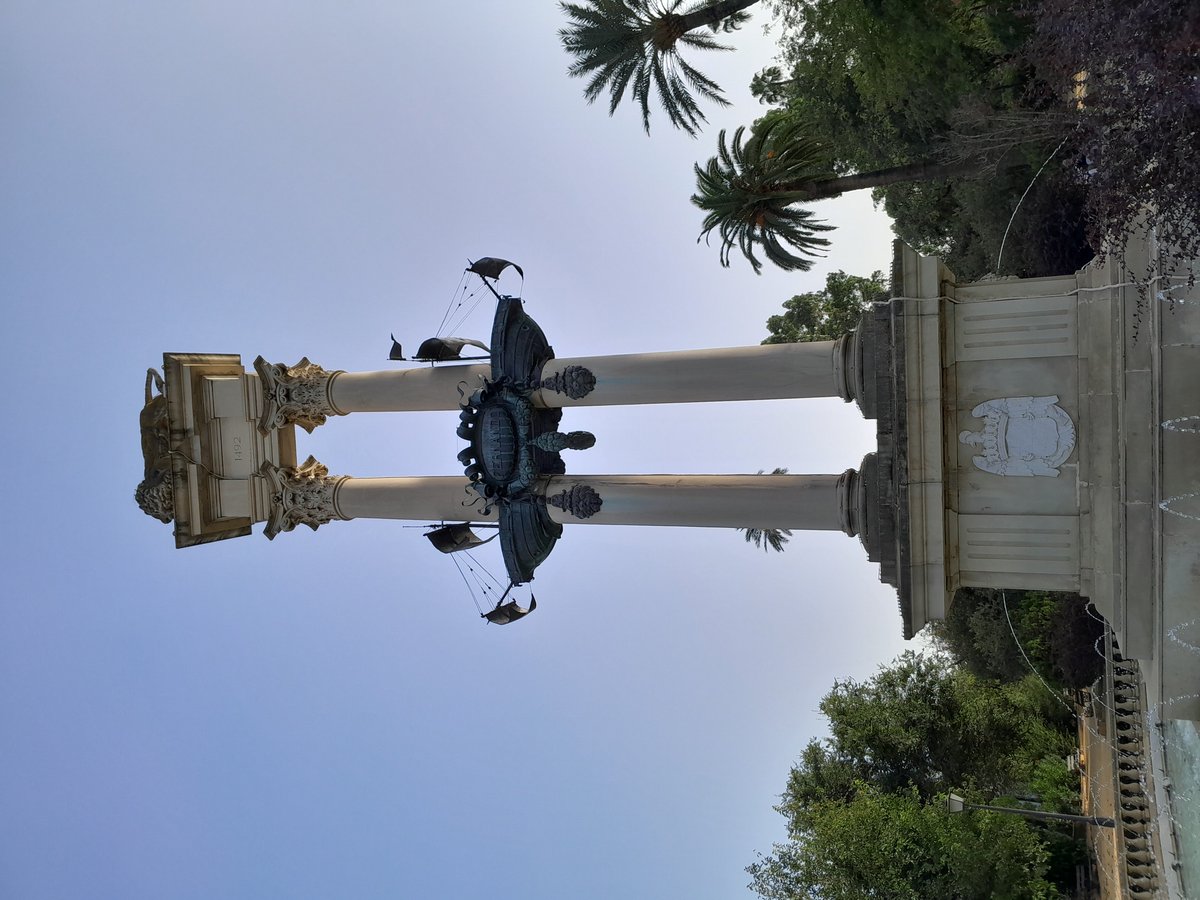
Visiting Monumento a Cristóbal Colón in Seville: History, Tickets, and Tips
Date: 18/07/2024
Introduction
The Monumento a Cristóbal Colón in Seville, Spain, is a monumental tribute to the legendary explorer Christopher Columbus and stands as a testament to Spain’s rich historical and cultural heritage. Situated at the southeastern end of the Jardines de Murillo, the monument is strategically located near the Guadalquivir River, where Columbus’s ships were outfitted for his historic voyages. This iconic landmark is not only a symbol of Spain’s Age of Exploration but also a reflection of the nation’s architectural ingenuity and artistic expression from the late 19th century (source).
The idea for a grand monument dedicated to Columbus was first proposed in the 19th century, a time marked by a renewed sense of Spanish nationalism. Seville, with its historical ties to Columbus and the Spanish explorations of the Americas, was chosen as the ideal location for this ambitious project. After several design iterations, Arturo Mélida’s winning design was selected in 1885. Mélida’s vision incorporated a blend of Neo-Gothic and Renaissance architectural styles, encapsulating the eclectic tastes of the era (source).
Construction of the monument began in 1891 and was completed in 1929. The structure features a towering 70-foot column topped with a bronze statue of Columbus, surrounded by allegorical figures representing the kingdoms of León, Castilla, Navarra, and Aragón. The monument also serves as the official resting place of Columbus, with his tomb located at the base of the column, carried by larger-than-life bronze statues of historical figures (source).
This guide provides a comprehensive overview of the Monumento a Cristóbal Colón, covering its historical significance, architectural features, visitor information including ticket prices and visiting hours, and nearby attractions. Whether you’re an avid history buff or a curious traveler, this guide will help you make the most of your visit to this remarkable landmark in Seville.
Table of Contents
- Introduction
- History and Significance of the Monument
- Design and Architectural Features of the Monument
- The Monument’s Setting - A Harmonious Blend
- Visitor Information
- Nearby Attractions
- FAQ
- Conclusion
History and Significance of the Monument
Early Concepts and Construction
The idea for a grand monument dedicated to Columbus in Seville was first proposed in the 19th century, a period marked by a resurgence of Spanish nationalism. Seville, with its historical ties to Columbus and the Spanish exploration of the Americas, was chosen as the ideal location.
The monument’s design went through several iterations and controversies. The winning design, by Arturo Mélida, was selected in 1885. Mélida envisioned a grand structure that would not only serve as a tomb for Columbus (whose remains were brought to Seville from Havana in 1899) but also as an allegory for Spain’s imperial past.
Construction began in 1891 and was completed in 1929, showcasing a blend of architectural styles, primarily Neo-Gothic and Renaissance, reflecting the eclectic tastes of the time.
The Monument’s Design and Symbolism
The monument’s centerpiece is a towering 70-foot-tall column composed of four stages, culminating in a bronze statue of Columbus pointing towards the Americas. Flanking the column are four allegorical figures representing the kingdoms of León, Castilla, Navarra, and Aragón, symbolizing the unified Spain that sponsored Columbus’s voyages. These figures, along with the intricate reliefs and sculptures adorning the monument’s base, further emphasize Spain’s historical narrative of exploration and conquest.
The Tomb of Columbus
Perhaps the most significant aspect of the monument is its function as the tomb of Christopher Columbus. While the exact location of his remains has been a subject of debate, the monument in Seville is recognized as his official resting place.
The tomb itself is located at the base of the column. Four larger-than-life bronze statues, representing the historical figures of Pedro González de Mendoza (Cardinal of Spain), Martín Alonso Pinzón (captain of the Pinta), Vicente Yáñez Pinzón (captain of the Niña), and a fourth figure often identified as a priest, act as pallbearers, carrying the sarcophagus containing Columbus’s remains.
The Monument’s Legacy
The Monumento a Cristóbal Colón stands as a powerful symbol of Spain’s complex relationship with its imperial past. While it celebrates the spirit of exploration and discovery, it also serves as a reminder of the colonization and its consequences for indigenous populations in the Americas.
Today, the monument is a popular tourist destination, attracting visitors from around the world. It serves as a starting point for exploring Seville’s rich history and its connection to the Age of Exploration.
Design and Architectural Features of the Monument
The Monumento a Cristóbal Colón in Seville is a remarkable example of 19th-century eclectic architecture, blending various styles to create a visually stunning landmark.
The Column - A Symbol of Achievement
The most prominent feature of the monument is the towering column, standing at a height of 149 feet (45 meters). This height is no coincidence, as it symbolizes the year 1492, the year Columbus embarked on his historic voyage. Constructed from reddish marble quarried in the nearby town of Carmona, the column is not a single monolith but rather a series of drums fitted together, showcasing the engineering prowess of the time.
The Pedestal - A Stage for History
The column rests on a grand pedestal, richly adorned with intricate sculptures and reliefs that narrate the story of Columbus and his voyages. Crafted from white stone, the pedestal provides a stark contrast to the reddish column, further emphasizing its grandeur.
Symbolic Sculptures
Four allegorical figures representing the Kingdoms of Castile, León, Aragon, and Navarre grace the corners of the pedestal. These figures, each holding a shield and standing on a prow, symbolize the unity of Spain during Columbus’s time and their support for his expeditions.
Narrative Reliefs
The pedestal’s sides are adorned with elaborate bronze reliefs depicting scenes from Columbus’s life and voyages. These reliefs, crafted with meticulous detail, offer a glimpse into the explorer’s journey, from his departure from Palos de la Frontera to his encounters with the indigenous people of the Americas.
The Victory - A Crowning Achievement
Perched atop the column, a bronze statue of Victory stands triumphant, her wings outstretched as if about to take flight. This figure, often mistaken for Columbus himself, represents the victory of human endeavor and the spirit of exploration.
The Lions - Guardians of History
At the base of the monument, four majestic lions stand guard, adding a sense of regality and power. These lions, sculpted from white stone, are not merely decorative; they symbolize the strength and courage required for exploration and discovery.
Architectural Styles - A Fusion of Influences
The Monumento a Cristóbal Colón beautifully exemplifies the eclectic architectural style prevalent in the late 19th century. This style, characterized by the blending of elements from different historical periods, is evident in the monument’s design.
Neo-Gothic Influences
The monument’s overall verticality, the pointed arches framing the reliefs, and the intricate details on the pedestal hint at Neo-Gothic influences. This style, popular during the 19th century, sought to revive the grandeur and spirituality of medieval Gothic architecture.
Renaissance Inspiration
The use of classical figures, such as the allegorical representations of the Spanish kingdoms and the Victory statue, draws inspiration from the Renaissance period. This era celebrated human achievement and classical ideals, making it a fitting influence for a monument dedicated to Columbus.
Mudejar Echoes
The monument’s use of colorful tiles and intricate geometric patterns, particularly on the pedestal, subtly echoes the Mudejar style, a unique architectural tradition that flourished in Spain during the Middle Ages. This style, characterized by the blending of Islamic and Christian artistic elements, adds a touch of local flavor to the monument.
The Monument’s Setting - A Harmonious Blend
The Monumento a Cristóbal Colón is strategically positioned at the Plaza de Colón, a bustling square near the Guadalquivir River. This location, once the site of the Puerta de Jerez, one of the city’s historic gates, connects the monument to Seville’s rich past.
Urban Integration
The monument’s design seamlessly integrates with its surroundings. The open space of the plaza allows visitors to appreciate the monument from various angles, while the surrounding gardens provide a tranquil setting.
Visual Axis
The monument’s location creates a visual axis with the Torre del Oro, another iconic landmark on the banks of the Guadalquivir River. This connection between two significant monuments, one representing Seville’s past as a port city and the other commemorating a pivotal moment in exploration, adds a layer of historical depth to the experience.
Visitor Information
Ticket Prices and Visiting Hours
- Visiting Hours: The Monumento a Cristóbal Colón is open to the public daily from 9 AM to 7 PM.
- Ticket Prices: General admission is €5, with discounts available for students, seniors, and children under 12.
Travel Tips
- Best Time to Visit: Early morning or late afternoon to avoid the midday heat and crowds.
- Getting There: Easily accessible by bus, tram, or a short walk from the city center.
- Nearby Attractions: Don’t miss the nearby Alcázar of Seville, Seville Cathedral, and the charming Barrio Santa Cruz.
Special Events and Guided Tours
- Special Events: The monument often hosts cultural events and exhibitions, especially during significant anniversaries related to Columbus.
- Guided Tours: Available in multiple languages, providing deeper insights into the monument’s history and architectural details.
Photographic Spots
- Best Angles: Capture the monument from the Plaza de Colón or include the Torre del Oro in the background for a stunning shot.
Nearby Attractions
The Monumento a Cristóbal Colón is ideally situated in the heart of Seville, surrounded by a wealth of historical and cultural attractions. Here are some notable places to visit within walking distance:
Plaza de Toros de la Real Maestranza de Caballería de Sevilla
Just a stone’s throw from the monument, you’ll find the iconic bullring of Seville, the Plaza de Toros de la Real Maestranza. This architectural masterpiece is one of the oldest and most prestigious bullrings in Spain, steeped in history and tradition. Even if you’re not attending a bullfight, a guided tour of the bullring and its museum offers a fascinating glimpse into this integral part of Spanish culture.
Archivo General de Indias
History buffs won’t want to miss the Archivo General de Indias, a UNESCO World Heritage Site located just across the street from the monument. This impressive archive houses an unparalleled collection of documents relating to the Spanish Empire in the Americas, including maps, charts, and manuscripts dating back to the 16th century. Exploring its vast halls is like taking a journey through time, uncovering the stories of explorers, conquistadors, and the indigenous peoples they encountered.
Alcázar of Seville
A short walk from the monument will lead you to the Alcázar of Seville, a breathtaking royal palace that seamlessly blends Moorish and Christian architectural styles. This UNESCO World Heritage Site boasts opulent interiors, serene courtyards adorned with fountains and fragrant orange trees, and intricate tilework that will leave you in awe. Allow ample time to wander through its enchanting gardens and discover hidden corners of this historical gem.
Seville Cathedral and La Giralda
No visit to Seville is complete without marveling at the grandeur of the Seville Cathedral, the largest Gothic cathedral in the world and another UNESCO World Heritage Site. Its sheer size and architectural splendor are awe-inspiring. Climb to the top of La Giralda, the cathedral’s bell tower, for panoramic views of the city. Originally a minaret dating back to the Moorish period, La Giralda offers a unique perspective on Seville’s rich history and architectural tapestry.
Plaza de España
A leisurely stroll along the Guadalquivir River will take you to the Plaza de España, a sprawling plaza built for the Ibero-American Exposition of 1929. This architectural marvel showcases a blend of Renaissance Revival and Moorish Revival styles, with a semi-circular brick building adorned with intricate tilework and bridges spanning a canal. Rent a rowboat for a unique perspective of the plaza or simply relax on a bench and soak up the vibrant atmosphere.
Barrio Santa Cruz
Lose yourself in the charming labyrinthine streets of Barrio Santa Cruz, Seville’s historic Jewish quarter. This atmospheric neighborhood is a delight to explore on foot, with its narrow cobblestone streets, whitewashed buildings adorned with flower-filled balconies, and hidden squares bustling with tapas bars and flamenco venues. Discover hidden courtyards, admire the intricate tilework, and savor the flavors of Andalusian cuisine in this captivating neighborhood.
Museo de Bellas Artes de Sevilla
Art enthusiasts should make their way to the Museo de Bellas Artes de Sevilla, housed in a former convent and considered one of the finest art museums in Spain. Its collection spans from the medieval period to the 20th century, with a particular focus on Spanish Baroque painting, including masterpieces by renowned artists such as Murillo, Zurbarán, and Valdés Leal. The museum’s tranquil courtyards provide a peaceful respite from the bustling city.
Parque de María Luisa
Escape the city buzz and find tranquility in the Parque de María Luisa, a sprawling green oasis located a short walk from the monument. This expansive park offers a welcome respite from the heat, with shaded pathways, serene ponds, and colorful flower gardens. Rent a bike to explore its vast expanse or simply relax on a bench and enjoy the peaceful ambiance. The park is also home to the Plaza de América, a picturesque square featuring a variety of museums and architectural landmarks.
FAQ
What are the visiting hours for Monumento a Cristóbal Colón?
The monument is open daily from 9 AM to 7 PM.
How much are the tickets for Monumento a Cristóbal Colón?
General admission is €5, with discounts available for students, seniors, and children under 12.
Are there guided tours available?
Yes, guided tours are available and can be booked online or on-site. These tours provide in-depth information about the monument’s history and significance.
Is the Monumento a Cristóbal Colón accessible to visitors with disabilities?
The monument and surrounding area are generally accessible to visitors with disabilities. However, access to the interior and viewpoint might be limited. It’s recommended to contact the monument administration in advance to inquire about specific accessibility features.
Conclusion
The Monumento a Cristóbal Colón in Seville stands as a powerful symbol of Spain’s complex relationship with its imperial past and its spirit of exploration. This monumental structure, with its intricate design and rich historical significance, offers a unique glimpse into the era of Spanish exploration and the legacy of Christopher Columbus. From the towering column and symbolic sculptures to the tomb of Columbus himself, the monument encapsulates a blend of architectural styles and historical narratives that make it a must-visit destination for anyone exploring Seville (source).
Located in a public square near the Guadalquivir River, the monument is easily accessible and surrounded by other notable attractions such as the Alcázar of Seville, Seville Cathedral, and the Archivo General de Indias. Visitors can enjoy a rich cultural experience by exploring these nearby sites, each offering its own unique contribution to Seville’s historical tapestry (source).
Whether you’re visiting for its historical significance, architectural beauty, or simply to enjoy a day out in Seville, the Monumento a Cristóbal Colón offers something for everyone. Don’t forget to check the latest visitor information and guided tour options to make the most of your visit. This guide aims to provide all the necessary details to ensure a fulfilling and enriching experience at this iconic landmark (source).
References
- Exploring the Monumento a Cristóbal Colón in Seville - History, Tickets, and Visiting Hours, 2024, Audiala source
- Exploring the Monumento a Cristóbal Colón in Seville - Design, History, and Visitor Tips, 2024, Audiala source
- Your Ultimate Guide to Visiting the Monumento a Cristóbal Colón in Seville - Hours, Tickets, and Nearby Attractions, 2024, Audiala source
